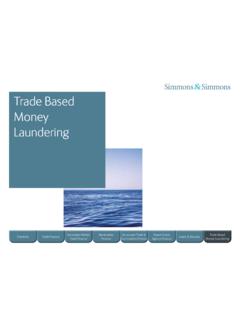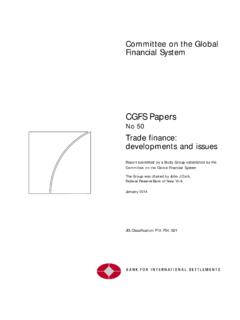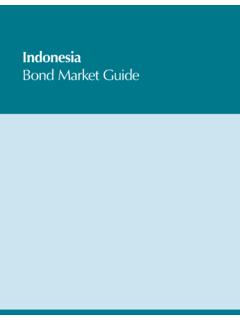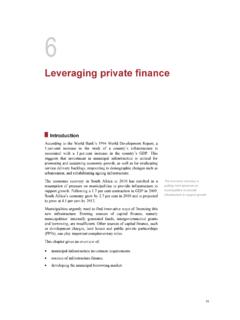Transcription of Structures and Solutions in Trade Finance - Legal resource
1 Structures and Solutions in Trade FinanceStructures & Solutions in Trade Finance is a guide to the different Structures in Trade Finance . Trade Finance is a term used to describe an array of different financing techniques. Often these lending Structures , the mechanics involved and core features can be & Simmons has created Structures & Solutions in Trade Finance to give a basic pictorial guide to some of the different Structures associated in Trade Finance . Our guide sets out the flow of goods, the flow of documents and the flow of money and receivables to enable the user to easily see the financing supply chain and Trade cycle of different Trade & Finance Structures & Solutions in Trade Finance is the Simmons & Simmons A to Z of Trade Finance which is a glossary of terms commonly used in international Trade and Trade & Simmons recognises the world of Trade Finance develops and moves incredibly quickly. Therefore, we have designed Structures & Solutions in Trade Finance to be easily updated and we will publish new Structures , regular commentaries and notes that can all be kept together in this & Solutions in Trade Finance is the essential companion ensuring all those involved in the Trade of goods and services, import and export, the supply chain and, of course Trade Finance , all speak a common FinanceOpen AccountDocumentary CollectionsDocuments against Payments (D/P)Documents against Acceptance (D/A)Opening a Letter of CreditOperating a Letter of CreditDiscounting AcceptancesNegotiating Export L/CConsignmentTrust Receipt FinancingBPO (Bank Payment Obligation)Secondary Market Trade FinanceBank-to-Bank Trade Finance LoansBAFT Sub-participation (Funded or Risk Participation)
2 LC RefinancingLC Reimbursement Bill of Exchange and Aval GuaranteeReceivables FinanceLoan Secured against ReceivablesFactoringForfaitingReceivable s Discounting Supply Chain / Payables FinanceDistributor FinanceStructured Trade & Commodities FinancePre-shipment FinancePre-export FinancingPrepayment FinancingWarehouse and Inventory FinancingRepurchase (Repo)Borrowing Base LendingLease FinancingExport Credit Agency FinanceSupply Credit: ECA Loan and Facility GuaranteesSupply Credit: Insurance CoverSupply Credit: Bills and Notes Facility GuaranteeLoans & SecurityTrade Finance FacilityUnsecured Facility (Bilateral)Secured Facility (Bilateral) Secured Facility (Subordination)Syndicated Secured FacilityLMA Sub-participation (Funded or Risk Participation) Trade Based Money LaunderingInvoice FraudUnderinvoicingOverinvoicing Tax and Transfer PricingU-Boating ShipmentsHawala Payment SystemsBlack Market Currency ExchangeSanctions CircumventionelexicaKey Document / Contract flow Money flow Receivable flow Cargo / Goods flow Security / Collateral flowTrade FinanceTrade FinanceSellerSeller BankBuyerBuyer Bank1a1b243 Mechanics1a Goods shipped from Seller to Buyer pursuant to a Contract of Invoice sent upon delivery to Invoice payment made to the Buyer s bank, normally in local Bank transfer monies to and notifies Seller s bank through the SWIFT Payment made to Seller, or credited to Seller s account in local or foreign currency according to invoice and/or Seller s FinanceOpen AccountWhat is it?
3 1. Trade transactions between a Seller and a Buyer where transactions are not supported by any banking or documentary Trade instrument issued on behalf of the Buyer or The goods are shipped from the Seller to the Buyer before the payment is due and payment is made through the banking features1. Beneficial for an importer and involves fewer parties but contains high-risks for exporters. Open Account carries lower costs because the number of parties are fewer and procedures are less Goods and invoice are delivered directly from Seller to the Buyer who will pay the invoice on the maturity date. The goods are shipped from the Seller to the Buyer before the payment is Exporters need to have a good understanding of, confidence in, the risks associated with the importer and the importing country. Open Account tends to be used in mature trading relationships and developed markets. Alternatively if the Seller has concern on Buyer on country risk then alternative default mitigating products such as Trade credit insurance can be obtained.
4 4. Open Account can be more responsive to sudden unexpected changes in contractual arrangements. It can be relatively simple as it concentrates on the contractual terms agreed between the parties. For example, dealing with discrepancies in the Shipping Documents is straight forwarded between Buyer and Seller There are relatively fewer structural financing opportunities in Open Account. However, it is likely the bank will be able to offer Open Account as part of its general banking services associated with a Trade Finance Facility (see Trade Finance Facility). Trade FinanceOpen AccountSeller Remitting BankBuyerCollecting/ Presenting Bank1b26a6b456a31a6cMechanics1a Seller enters into Contract of Sale with the Seller initiates shipment of goods and loads/ships goods via Shipper or Carrier to the Seller submits Collection Order, Bill of Exchange and Shipping Documents to Remitting Remitting Bank forwards documents to Collecting Bank also known as Presenting Collecting Bank must act in accordance with Remitting Bank s instruction.
5 Collecting Bank can arrange for Buyer to inspect the documents. If Buyer considers documents are in order, the Collecting Bank releases them against payment or In a Clean Collection, Buyer pays Seller via banks or accepts Draft (in which a Term Bill of Exchange will remain with the Collecting Bank until Maturity).6a Money sent to Remitting Bank and credit Seller s Documents released to the Buyer 6c Buyer now has Shipping Documents to enable collection of goods from the FinanceDocumentary CollectionsWhat is it?Documentary Collections is an inter bank document handling system. A collection service provided by a bank under which the Shipping Documents relating to a cargo are sent to a Buyer but only released once the Seller has the comfort that goods will be paid for by the Buyer. It is a means whereby the Seller in one country can obtain payment from the Buyer in another and the Buyer can obtain the Shipping Documents and, therefore title to the goods, through the banking system in his own features1.
6 Documents are released to the Buyer on payment (Documents Against Payment: D/P) or released to the Buyer on acceptance of a Bill of Exchange (Documents Against Acceptance: D/A).2. Standard international ICC rules URC 522 govern the roles and responsibilities of the various banks Banks will arrange collections of the financial documents such as a Bill of Exchange or Promissory Note and the Shipping Documents such as Bills of Lading and the Commercial Outward Collections is where a bank obtains payment from the Buyer on behalf of Inward Collections is where the bank assists a correspondent bank to obtain payment of a Draft or Promissory Notes or cheque from the Buyer on behalf of Bank s instruction from the Seller to its Remitting Bank is called a Collection FinanceDocumentary Collections3 Seller Remitting BankBuyerCollecting Bank1b24651a6 Mechanics1a Under a Contract of Sale, the Seller agrees to ship goods and send documents via Documentary Collections Seller initiates shipping goods to Buyer and hands over goods to Shipper or Seller sends documents to Remitting Bank together with payment Seller s bank checks the Seller s instructions and that they conform with the documents.
7 Then send to the Buyer s bank, known as the Collecting Buyer is advised about Collection by the Collecting Bank. Before payment, Buyer has the right to inspect documents and that they all conform to what is required as specified in the Contract of Sale. If Buyer is satisfied then the Buyer instructs his bank to pay the Payment is transferred to Remittance Bank according to payment instructions and credited to Seller s Documents are then simultaneously released to the Buyer and the Buyer can collect the goods from the Shipper or Carrier. Trade FinanceDocuments against Payments (D/P)What is it?The Seller entrusts the goods and title documents to the Seller s bank, also giving it payment instructions as agreed between the Seller and the Buyer in the Contract of Sale. Once the Buyer has made a payment to the Seller s bank, the Buyer can then receive the Shipping Documents and thus access to the goods while paying following the payment features1. A key advantage over Open Account is that if the Collection documents include a full set of Bills of Lading then the goods remain in control of the Seller (or at least within the Collection system) until actual Shipping Documents often used include: Draft/Bill of Exchange issued at sight or as a term bill (Usance bill) Commercial invoice Specifications and packing or weight lists Transport documents, such as Bills of Lading, Waybill or Multimodal Transport Documents Certificate of origin Inspection certificates verifying quality or quality of the goods Insurance documents3.
8 What if the Commercial Documents are not a Bill of Lading ( a Waybill)? If this is the case, then the Seller, in the Collection Order, can specify to consign the goods to the Collecting Banks order who will only release them when the Buyer makes the FinanceDocuments against Payments (D/P)Collecting Bank35 Seller Remitting BankBuyer1b264a61a4bMechanics1a Under a Contract of Sale, the Seller agrees to ship goods and send documents via Documentary Collections Seller initiates shipping goods to the Buyer and hands over goods to Shipper or Seller sends documents via Documentary Collections to Seller s bank together with payment instructions and a Bill of Exchange. A Bill of Exchange is payable (i) on sight or (ii) at the maturity date stated (this is known as a Term Bill or Time Bill).3 Seller s bank checks the Seller s instructions and that they conform with the documents. Then those documents are sent to Buyer s bank otherwise known as the Collecting The Buyer is advised about collection by his bank.
9 After satisfactory inspection, the Buyer will Accept the enclosed Bill of Exchange (an Accepted Draft) and receives the documents attached to the Bill of Exchange. Most commonly referred to as the Shipping Documents. This will include the title documents relating to the The Buyer can then present the Shipping Documents to the Carrier and collect the The Bill of Exchange (the Accepted Draft) is given to Seller s bank and the Accepted Draft is kept at Seller s bank until the maturity On the maturity, the Accepted Draft is presented for payment to Collecting Bank as a Clean Collection (that is without other shipping documents) and the Buyer s bank makes payment to Seller s bank as per Seller s payment FinanceDocuments against Acceptance (D/A)What is it?The documents transferring title of goods are delivered to the Buyer via the banking and Collection system. Only upon the Buyer s Acceptance of the Seller s Bill of Exchange guaranteeing payment at a later date will the documents relating to the goods be released to the features1.
10 Seller is granting commercial credit terms to the Buyer. The period of credit is the term of the Bill of When the Buyer accepts the Draft he can be released with the Shipping Documents and claim the goods. Therefore, D/A collections offer less protection because the Buyer takes title to the goods before he has to pay. However, the Buyer is acknowledging his debt by Acceptance of the Draft. If the Seller is concerned with the credit of the Buyer he may insist on the Draft being avalised by the Issuing Bank, thereby adding an additional payment The Bill of Exchange will be held with the Collecting Bank until maturity at which time it will be presented for payment, or alternatively the Seller might be prepared to seek earlier financing based on the Buyer s Structures1. The Seller can obtain early payment from the Remitting Bank via an advance or prepayment against the Collection. Advances are usually full recourse to the Seller. 2. Or the Seller can obtain non-recourse financing where the Bills of Exchange are avalised or Bills are accepted by a high credit of the An aval is a guarantee added to the Acceptance of the Bill by the Collecting Bank by giving an unconditional undertaking to pay on maturity of the Bill.







